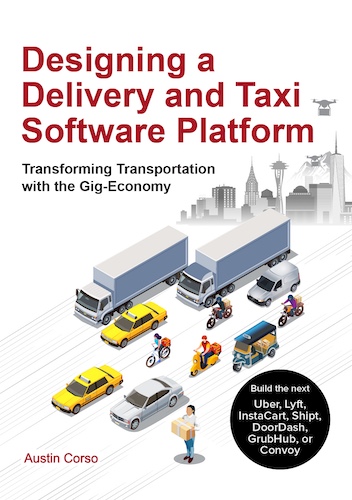The sharing economy has given rise to a wave of new online multi-sided marketplace apps and business models, where consumers and sellers are matched across a unique, differentiated set of products and services. In this series, we will explore the applications, domains, and software subsystems applicable to a wide variety of transportation use cases – from restaurant and grocery delivery (e.g. DoorDash, Instacart), to taxi and rideshare services (e.g. Uber, Lyft), to third-party deliveries and shipments (e.g. Shipt, Convoy, Uber Freight).
Each of these businesses has successfully created a marketplace that matches customers with a wide variety of sellers offering differentiated products or services, rather than standardized items. This creates a more complex system than traditional retail as it presents a complex optimization problem where we must balance the multiple needs across a diverse set of users - times/dates, locations, qualifications / features / amenities, availability, regional regulations, and so forth. Additionally, the rules and functioning of the marketplace need to be considered carefully to prevent gaming and ensure a fair and transparent marketplace for all parties.
In this 8-part e-book, we will design a multi-sided online marketplace encompassing multiple domains, subsystems, and applications, with principles which can be applied to a wide variety of marketplace and gig-economy use cases from taxi services (e.g. Uber, Lyft), to restaurant delivery (e.g. DoorDash, Postmates), to third-party deliveries (e.g. Instacart, Shipt, Convoy). We’ll focus on a complex three-sided marketplace use-case involving three distinct sets of users: customers making purchases, third-party vendors, and gig-economy drivers. By the end we will have designed a global transportation platform with multi-sided marketplace where (i) consumers can shop through a variety of vendors (3rd-party merchants or taxi services), (ii) have their goods or themselves delivered quickly – as quick as same-hour, (iii) by gig-economy drivers, (iv) either scheduled-ahead or on-demand, (v) all without merchants or taxi companies managing any of the logistical complexity.
We must balance: speed, low-cost, and accurate-ETA’s for customers; consistent, highly-available taxi & delivery services for third-party merchants and taxi companies; and fairness, transparency, and consistency for gig-economy drivers. The platform will support a wide range of transport speeds starting as quick as same-hour with low latency APIs to optimize the checkout flow for maximum conversion. We will support multiple pick-up and drop-off locations, given products and customers will be distributed. Finally, we will support multiple mechanisms for gig-economy drivers to obtain work, either scheduling work ahead to guarantee sufficient working hours or working on-demand with maximal flexibility, obtaining work in real time.
- Part 1: Introduction, Requirements, Mobile and Web Applications
- Part 2: Backend Infrastructure and Service Architecture
- Part 3: Vendor Management and 3rd Party Customer Shopping & Checkout
- Part 4: Transport Supply & Demand Management and Forecasting with Machine Learning
- Part 5: Route Planning, ETAs, and Dynamic Pricing with Machine Learning
- Part 6: Driver Onboarding, Preferences, Standings, Rewards, and Payments
- Part 7: Driver-Route Targeting, Pushed On-Demand Routes, and Precomputed Eligibility
- Part 8: Gig-Economy Route Marketplace for Schedule-Ahead Routes with Deferred Route Matching
Part 6: Driver Onboarding, Preferences, Standings, Rewards, and Payments
Introduction
In Part 1, we envisioned a global transportation software platform enabling third-party vendors to rapidly transport goods to customers – or customers themselves – within an hour, covering requirements, web/mobile apps, and overall flows. In Part 2, we explored the backend infrastructure and service architecture. In Parts 3-8, we are diving into the domains, subsystems, and services required. Here in Part 6, we discuss the Driver, Rewards, and Payments domains.
To provide a high-functioning multi-sided marketplace requires the platform implement mechanisms which promote good behaviors and offer continuous work opportunities for high performing gig-economy drivers. First and foremost, drivers need to register and onboard to the transportation platform. Second, we will need a mechanism for drivers to state their route preferences and for us to continuously learn and adapt as their preferences change. To track driver performance, prioritize reputable drivers, and deny drivers with repeat failures, the platform will maintain drive standings. Finally, to promote drivers who are successfully completing routes, the platform will implement a rewards system with rewards tiers which provide driver’s bonuses and promotions.
Driver
The Driver domain is responsible for onboarding and managing the gig-economy drivers, including their preferences and standings.
Driver Onboarding
When new drivers open the driver-facing mobile app for the first time they will be invited to register for the program.
The Driver Management Service's onboarding API facilitates walking driver’s through the six-step onboarding and registration workflow. This involves driver:
- Identity verification and work authorization
- Background check
- Driving eligibility and record
- Vehicle and insurance
- Payment info
(1) Identity Verification and Work Authorization
The first step in onboarding a driver is to verify their identity. This is a critical first component to ensure compliance (e.g. Know Your Customer (KYC)), minimize fraud, prevent bad actors, and restrict automated bots. Driver’s will need to upload documentation to verify their identity, including their: legal name, date of birth, address, and either a license ID number, social security number, or similar identity number. This information will require the highest security controls, including encryption both at-rest and in-transit. We’ll leverage a third-party service to cross-reference this information with government offices and securely store the high-PII (personally identifiable information) documents.
The remainder of this chapter is available by purchasing the e-book.
